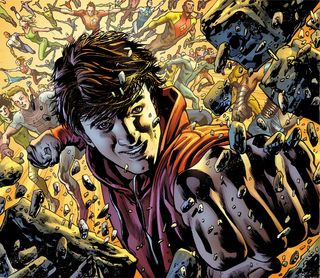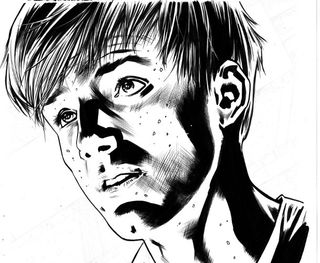Jonathan Ross and Bryan Hitch Talk America's Got Powers
The king of chat and the master of art build a new superhero universe...
Today sees the release of issue one of America's Got Powers , the new comic book collaboration between Jonathan Ross and Bryan Hitch. They spoke exclusively to SFX about creating their high-concept, superpowered spin on the merciless world of reality TV...

Jonathan, what are you challenging Bryan to draw with this project?
Jonathan Ross: Well, Bryan can draw everything, but partly I want him to do stuff he hasn’t done before. And he’s doing that, in a way. Bryan does the emotional character stuff really well, and I probably write a lot more of that stuff than Mark [Millar] does now, though in The Ultimates there was a lot of that soap opera stuff going on… I really like that in comics. I still really want to do a romance comic book.
Bryan Hitch: I’d draw that, too. People talk about my work being widescreen and cinematic but you can draw somebody smoking a cigarette cinematically, in widescreen.. It’s how you frame a shot and how you light it and how you have the person acting. It’s not the amount of action that’s going on. So as much as I love drawing the big action stuff, what I love is the balance. I don’t like just heavy action, I don’t like just pointless characterisation. And I like to have the dialogue to work with rather than the art direction. I like to know what people are saying, because that gives you a chance to have the characters act properly and emote properly. And how you choose to tell the story using the characterisation is very important – it’s often overlooked, I think. With The Ultimates the assumption was that because it was there in the finished book that Mark must have written it exactly like that. And no matter how many times Mark tells people that that was me, they don’t believe it, because they assume it had to be written first before I could draw it.
J: There are so many different ways of making comic books. That’s what’s interesting. You look back at the Kirby-Lee way, or Stan Lee’s way with everyone, really… Just by the sheer volume he produced, you imagine he basically came up with broad beats of action and soap opera type emotion. And you can see the artists who knew how to make it work, knew how to create the rhythm of the piece. The two greats he worked with were Kirby and Ditko, who understood how to tell a story, that you needed to go from action to a quiet moment of intimacy to a bigger moment of soap opera to more action, to a small moment of action that would also serve the narrative of a character… you could see they were serving it up for Lee to then apply this incredible kind of breezy, zeitgeisty dialogue. But he couldn’t have written that many scripts in a month and been on top of them all. So it worked. And in a way we’re working closer to that style with this, even though I am serving up page after page of dialogue.
B: And that’s actually what I’m working from. There’s one scene that you’d written as a three page scene, but when I actually worked through the dialogue it came out as two pages – a very tight two pages, which is good.
J: I’m more wary now after Turf , where I tried to put too much in each page. I try and write essentially four panels a page now, so when it spills over to five or six it’s still not too much. Whereas before I would write essentially what I thought the characters needed to say and then try to work out where to put it on a page.
Sign up to the SFX Newsletter
Get sneak previews, exclusive competitions and details of special events each month!
How important was it to launch with a giant-sized first issue?
J: We’re trying to set up our version of the Marvel universe, really. Let’s start with a bang, give people the big reading experience, do all the heavy lifting early on, set up the style of the piece, set up the world, show the scope of it… Basically there are four storylines, all converging, and even if you just give 3 or 4 pages for each of those that’s 12-15 pages right there. And then you want at least 10 pages of action…
B: But you’ve also got to let it breathe, and if you want people to believe the world you’re creating you have to let them inhabit it a little bit, which is why you have the characters moving around inside the world. You have to experience that world in a visual sense, not just in a tiny panel in the corner. There’ll be faster cuts in the second and third issues.
J: And that takes advantage of Bryan’s skills, creating these scenarios, the mise en scene. He really designs a universe.

So many people these days seem to be creating stuff for the trades – are you creating more for the issue by issue experience?
B: Both, actually. This story is complete as one unit, so it’ll read very well in the trades, but there’s no doubt we could have made issue one work as a 22 or 26 page story. But our determination to tell that first issue story the way we originally intended it to be told, even though it’s 38 pages, shows that we’re more interested in making the issues count, when they come out. That said, it will still work as a trade.
J: When they’re being written and when we’re putting the blocks in place we’re making sure that each book is a satisfying read, in and of itself. So in book two there’s a flashback which does a lot of character work for us, and then there’s present day stuff and we move forward the villain’s story arc and then we move forward the soap opera arc. I’m getting the feel for the rhythm of the 20 pages better than I ever had before. But also issue one should feel like a treat.
Do you think superheroes are still in the shadow of Watchmen ?
J: I don’t think superheroes are at all in the shadow of Watchmen , in the same way that graphic novels aren’t in the shadow of Maus or any of the other great books from that period. Those books are the tentpoles we all look to, and they bring new people in, but probably the most brilliant talent working in the graphic storytelling medium today is Chris Ware… the work he does is just mind-blowing, but it isn’t superheroes at all, and it doesn’t impinge in any way on what people do in superheroes or more adventure fun stuff. He’s David Lynch, and over there you’ve got Spielberg, and over there you’ve got Michael Bay. And say Alan Moore is David Fincher working with a really great screenplay from Sorkin. So The Social Network is ten times better than that dreadful rework they did of The Girl With The Dragon Tattoo , because the script was great. There’s room for everyone in here. There are a lot of kids out there buying superhero comics who’ve never read Watchmen , and might not enjoy Watchmen … And as a reader I want to read different voices, I want to read different sorts of stories.
Nick Setchfield
Read more from Jonathan Ross and Bryan Hitch on America's Got Powers in SFX 221, on sale now!

Nick Setchfield is the Editor-at-Large for SFX Magazine, writing features, reviews, interviews, and more for the monthly issues. However, he is also a freelance journalist and author with Titan Books. His original novels are called The War in the Dark, and The Spider Dance. He's also written a book on James Bond called Mission Statements.
Most Popular

